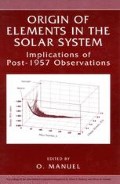Abstract
Hypersonic bipolar outflows are a ubiquitous phenomena associated with both young and highly evolved stars. Observations of Planetary Nebulae, the nebulae surrounding Luminous Blue Variables such as Eta Carinae, Wolf Rayet bubbles, the circumstellar environment of SN 1987A and Young Stellar Objects all reveal high velocity outflows with a wide range of shapes. In this paper I review the current state of our theoretical understanding of these outflows.
Access this chapter
Tax calculation will be finalised at checkout
Purchases are for personal use only
Preview
Unable to display preview. Download preview PDF.
References
Bachiller, R.: 1996, “Bipolar molecular outflows from young stars and protostars”, Ann. Rev. Astron. Astrophys., 34, 111–154.
Bachiller, R. and Gutierrez, M.P.: 1997, “Shock chemistry in bipolar molecular outflows”, in Herbig-Haro Flows and the Birth of Low Mass Stars, in IAU Symposium No. 182, eds., Reipurth, B. and Bertout, C., pp. 153–162.
Balick, B.: 1987, “The evolution of planetary nebulae. 1. Structures, ionizations, and morphological sequences”, Astron. J. 94, 671–678.
Balick, B., Perinotto, M., Maccioni, A., Terzian, Y. and Hajian, A.: 1994, “FLIERs and other microstructures in planetary nebulae, 2”, Ap. J. 424, 800–816.
Balick, B., Rugers, M., Terzian, Y. and Chengalur, J.N.: 1993, “Fast, low-ionization emission regions and other microstructures in planetary nebulae”, Ap. J. 411, 778–793.
Balick, B., Alexander, J., Hajian, A., Terzian, Y., Perinotto, M. and Patriarchi, P.: 1998, “FLIERs and other microstructures in planetary nebulae. IV. Images of elliptical pns from the Hubble space telescope”, Astron. J. 116, 360–371.
Bryce, M., Lopez, J., Holloway, A. and Meaburn, J.: 1997, “A bipolar, knotty outflow with velocities of 500 kilometers per second or above from the engraved hourglass planetary nebula MyCn-18”, Ap. J. 487, L161–L164.
Corradi, R.L.M. and Schwarz, H.E.: 1993, “Kinetics of bipolar nebulae”, Astron. Astrophys. 278, 247–254.
Dopita, M.: 1997, “What excites FLIERS?”, Ap. J. 485, L41–L44.
Frank, A., Balick, B., Icke, V. and Mellema, G.: 1993, “Astrophysical gasdynamics confronts reality-The shaping of planetary nebulae”, Ap. J. 404, L25–L27.
Frank, A., Balick, B. and Davidson K.: 1995, “An interacting stellar wind paradigm for Eta carinae”, Ap. J. 441, L77–L80.
Frank A., Balick B. and Livio M.: 1996, “A mechanism for the production of jets and ansae in planetary nebulae”, Ap. J. 471, L53–L56.
Frank, A. and Mellema, G.: 1994, “From the owl to the eskimo”, Ap. J. 430, 800–813.
Frank, A. and Mellema, G.: 1996, “Hydrodynamical models of outflow collimation in young stellar objects”, Ap. J. 472, 684–702.
Frank, A., Ryu, D. and Davidson, K.: 1998, “Where is the doughnut? Luminous blue variable bubbles and aspherical fast winds”, Ap. J. 500, 291–301.
Garcia-Segura, G. and MacLow, M.: 1995, “Wolf-Rayet bubbles. II. Gasdynamical situations”, Ap. J. 455, 160–174.
Hartigan, P., Morse, J.A., Heathcote, S. and Cecil, G.: 1993, “Observations of entrainment and time variability in the HH 47 jet”, Ap. J. 414, 121–124.
Henney, W.J. and Dyson, J.E.: 1992, “A dynamical model for the outer nebula of R Aquarii”, Astron. Astrophys. 261, 301–313.
Lada, C.J. and Fich, M.: 1996, “The structure and energetics of a highly collimated bipolar outflow: NGC 2264G”, Ap. J. 459, 638–652.
Latter, W.B., Kelly, D.M., Hora, J.L. and Deutsch, L.K: 1995, “Investigating the near-infrared properties of planetary nebulae. I. Narrowband images”, Ap. J. S 100, 159–167.
Martin, C.L. and Arnett, D.: 1995, “The origin of the rings around SN 1987A: An evaluation of the interacting-winds model”, Ap. J. 447, 378–390.
Mellema, G.: 1994, “The gasdynamic evolution of spherical planetary-nebulae-radiation-gasdynamics of Pne-III”, Astron. Astrophys. 290, 915–935.
Mellema, G. and Frank, A.: 1995, “Radiation gasdynamics of planetary nebulae-V. Hot bubble and slow wind dynamics”, Mon. Not. Royal Astron. Soc. 273, 401–410.
Mellema, G.: 1995, “Radiation gasdynamics of planetary nebulae-VI. The evolution of aspherical planetary nebulae”, Mon. Not. Royal Astron. Soc. 277, 173–192.
Mellema, G. and Frank, A.: 1997, “Outflow collimation in young stellar objects”, Mon. Not. Royal Astron. Soc. 292, 795–807.
Nota, A., Livio, M., Clampin, M. and Schulte-Ladbeck, R.: 1995, “Nebulae around luminous blue variables: a unified picture”, Ap. J. 448, 788–796.
O’Dell, C.R. and Handron, K.D.: 1996, “Cometary knots in the helix nebula”, Astron. J. 111, 1630–1645.
O’Dell, C.R., Weiner, L. and Chu, Y.-H.: 1990, “A kinematic determination of the structure of the double ring planetary nebula NGC 2392, the eskimo”, Ap. J. 362, 226–234.
Schwarz, H.E., Corradi, R.L.M. and Melnick, J.: 1992, “A catalogue of narrow band images of planetary nebulae”, Astron. Astrophys. Soc. 96, 23–113.
Author information
Authors and Affiliations
Editor information
Editors and Affiliations
Rights and permissions
Copyright information
© 2002 Kluwer Academic Publishers
About this chapter
Cite this chapter
Frank, A. (2002). Bipolar Outflows in Stellar Astrophysics. In: Manuel, O. (eds) Origin of Elements in the Solar System. Springer, Boston, MA. https://doi.org/10.1007/0-306-46927-8_21
Download citation
DOI: https://doi.org/10.1007/0-306-46927-8_21
Publisher Name: Springer, Boston, MA
Print ISBN: 978-0-306-46562-8
Online ISBN: 978-0-306-46927-5
eBook Packages: Springer Book Archive

